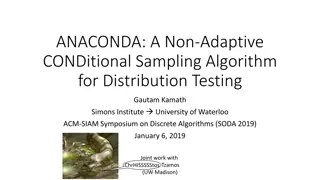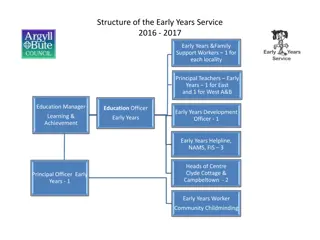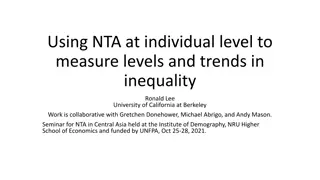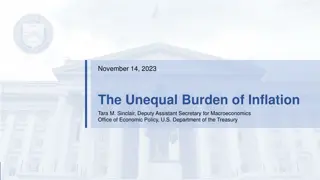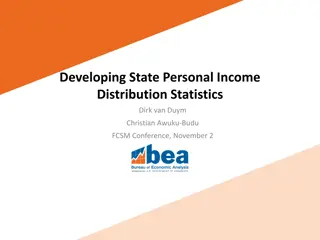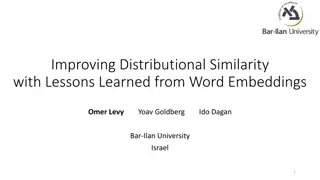Exploring US Distributional NTA: Early Results and Future Directions
US Distributional NTA project conducted by Ron Lee, Gretchen Donehower, Michael Abrigo, Andy Mason reveals early results for 2006-2018, including data on education, gender, social security inflows, and more. Future plans include analyzing individual NTA consumption, wealth distribution, labor force projections, fertility trends, and asset accumulation by education. Challenges lie in data availability for the institutionalized population and assumptions on their spending habits.
Download Presentation

Please find below an Image/Link to download the presentation.
The content on the website is provided AS IS for your information and personal use only. It may not be sold, licensed, or shared on other websites without obtaining consent from the author.If you encounter any issues during the download, it is possible that the publisher has removed the file from their server.
You are allowed to download the files provided on this website for personal or commercial use, subject to the condition that they are used lawfully. All files are the property of their respective owners.
The content on the website is provided AS IS for your information and personal use only. It may not be sold, licensed, or shared on other websites without obtaining consent from the author.
E N D
Presentation Transcript
US Distributional NTA first steps and early results Ron Lee, Gretchen Donehower, Michael Abrigo, Andy Mason May 4, 2020 Workshop on Micro-NTA
Most estimates just done yesterday and today, here show early results Various problems and distractions have delayed our work, so early work in progress but still interesting!
Here is what we have now All results are annual for 2006-2018, and will be extended back to 1981 soon. All results now include college students, prison inmates and people in nursing homes (institutionalized population). New. RESULTS Basic NTA, 2006-2018. NTA by education of head and by gender, 2006-2018. Distributions of yl, Soc Sec inflows, Total public cash inflows, Pub Educ inflows 2006-2018. (But not yet cons or wealth).
Where we want to go Distributions of individual NTA consumption, reflecting public and private transfers. Compare to distributions of individual primary incomes. Levels, trends. Distributions of wealth including transfer wealth, comparison to distributions without transfer wealth. Trends, comparison to levels and trends of inequality in bequeathable wealth, Piketty, Saez, Zucman. Projections of future labor force by education and its capacity to support future elderly. Concerns in US because high proportion of children is born to parents with low education and low income. Fertility and mortality by Educ Education of kids by education of parents
Where we want to go (cont.) Projections of saving and asset accumulation by education Capital intensification?
The Big Issues Large institutionalized population that consumes a lot of health care Data on covariates for that population are hard to come by Lots of assumptions about their spending Two surveys (Consumer Expenditure Survey, Current Population Survey) Full distributions require linking survey microdata, not just averages Health care Administrative data is available by age and sex, need to add a third and fourth survey to incorporate more covariates? Survey items changing over time
The Little Issues College & University Expense I get overall profile from enrollment rates at different types of institutions and tuition at those institutions Public education Right now it s just enrollment, I can add state-level variation in per pupil spending, but is that enough? Various other items
Labor income inequality over time (median of IQ/Med by age) Inequality is flat 2006 to 2008 (March). Inequality rises rapidly after Recession hits in July of 2008, rising until 2011. Then very slowly declining but still greater than pre-recession. Great recession
Ratio of labor income for college degree to less than high school The advantage of college degree relative to less than high school jumped when recession hit. Stayed high for years, but then plunged as labor market got tight and unemployment dropped to 5.6% in 2014. Now low education workers are doing better than before recession. Great recession
Ratio of male to female labor income dropped throughout Lower in 2018 than in 2006 Seems unrelated to recession Still two thirds higher for men.
Comparison to dALBIS & BADJI Their analysis is more complete and their measures are different, but still some comparison of inequality in labor income within age groups is of interest. Differences in measures Our yl is pretax; closest to us is their Gross Inc after social contributions but before other taxes. They calculate gini coefficients, decile shares, and quartile shares by age; we use Interquartile Range divided by Median Income at each age (problematic when median is low or zero, and tails of distrib have little effect). Their dates are 1996-2014, ours are 2006-2018.
Their results and ours for now; hope to be able to compare more in future. They find incomes became more unequal except ages 50-64. We also find increasing inequality, but also an 8% increase in inequality at ages 50-64 by our measure (IQ/Med). They find hump shaped inequality for gross income with inequality higher in the middle working ages. We find inequality flat from 25 to 50, then rising steeply.





